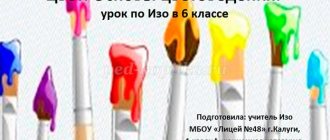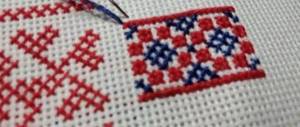Absolute color temperature.
Let's divide the color wheel into two halves. At the upper pole is the warmest color – orange. It is considered the warmest because it does not have cold shades; later we will look at this property in more detail. At the lower pole is the coldest color - blue. On the sides of the color wheel are temperature-neutral colors – green and purple. Both are formed by a mixture of cold and warm colors, green - yellow and blue, purple - red and blue. All colors in the top half are considered warm, while the colors in the bottom half are considered cool.
Achromatic colors: white, black and gray are neutral.
Cold and warm shades of colors.
Difficulties most often arise with determining the shade temperature. Concepts such as cold red or warm red have become firmly established in everyday life, but not everyone understands them to mean the same thing. First, relative hue temperature is often confused with color temperature. Secondly, subjectivity: there is no exact definition of where red begins and ends. Meanwhile, the ability to identify cold and warm tones is important when working with a person’s appearance, for example, determining color types and selecting individual color palettes. This skill can be developed through experience and understanding of a simple principle.
Any color except orange can have warm, neutral and cool shades. How to determine the temperature of a hue using the color wheel?
We take any color and determine its boundaries. Then we find the approximate center. Shades of color lying on the orange side will be warm. On the blue side - cold. Intermediate colors without admixtures of warm or cold are called local or neutral.
Let's take green first. It is formed by warm yellow and cool blue colors. A cool or warm green tint is obtained due to the preponderance of blue or yellow. Moving up towards yellow we get warm shades, down towards blue we get cool shades.
The same principle applies when identifying other colors, such as yellow. Approaching orange, the color warms up. Going down, yellow acquires a greenish, lemon, cold tint. Neutral yellow has no obvious greenish or orange tint.
The orange color stands out especially. This is the warmest and the only color that does not have cold shades. In addition, it distributes warmth to the surroundings. The closest colors: yellow-orange and orange-red are also exceptionally warm.
Red. The same principle applies here: the upper shades, illuminated by yellow, are warm, the lower ones, on the purple side, are cold.
Purple itself is a neutral color, like green, it is formed by a mixture of cool and warm colors. A large proportion of red makes it warm, blue makes it cold. From the point of view of use in warm or cold tones, this is a rather complex color. The differences between warm purple and cool red or cool purple and violet are difficult to discern. It is also difficult to isolate the local purple color.
The same difficulties in defining boundaries apply to purple. Adding red makes it warmer, adding blue makes it cooler.
The difficulty in determining the temperature of a shade is that there are no precise and generally accepted distinctions where the warm shade of one color ends and the cold shade of another begins. Local shades also have no clear boundaries. Usually, when we are dealing with the primary colors: red, blue, yellow and green, this division is intuitive; experience helps to distinguish between other colors.
Blue is the coldest color of the entire palette, it is the antipode of orange. But if orange makes neighboring colors extremely warm and has no cold shades, then blue does not have similar properties. Conventionally, a warm blue color can be distinguished. Some people believe that blue, by definition, cannot be warm, but a warm range of colors can also contain blue if you choose the right shade. Its cold, or local, shades are located in the middle, and its warm ones are located at the edges: on one side, blue is illuminated by yellow, on the other by red. These shades will be warmer than the cool blue.
Blue-green colors stand out separately. Here, warmth-coldness is conditional and depends on whether they are separated into a separate group with their own local color or considered as part of green and blue shades.
If we consider turquoise as a local color, then those located on the green side will be warm, and those located on the blue side will be cold.
If we consider blue as the local color, the same tones will be warm. Here, lightness and saturation are involved in determining color.
So, we come to the influence of lightness and saturation on color temperature. Up to this point, we have considered the properties of warmth and coldness in pure colors and one parameter - tone. But this is not enough, since most often you have to deal with complex colors that contain an admixture of achromatic ones, that is, take into account all three parameters. Lightness changes with the addition of white and black, saturation changes with the addition of gray.
Relative temperature. Cold and warm shades of colors.
Understanding relative temperature is important when working with multiple colors and color palettes. It helps, for example, to convey space and volume in an image or surface using color.
Apart from orange and blue, all colors can be both warm and cold relative to others. Using a color wheel, this is as easy to determine as absolute temperature. Warmth decreases as you approach the lower pole and blue color, for example, red or yellow will be cooler than orange, and lemon or magenta will be cooler than red and yellow. The same principle applies to increasing warmth: cyan and violet will be warmer than blue, turquoise and purple will be warmer still. Temperature gradations are especially evident in analogue and nuanced palettes.
A color can be warm or cold not only in relation to other colors, but also to its own shades.
Temperature of achromatic colors.
Pure achromatic colors are considered neutral. However, in nature it is difficult to find absolutely neutral gray, white or black; they always have an advantage in one direction. So, cold or warm white color is obtained from the admixture of other tones. Yellow-red ones make it warm, blue ones make it cold. The same applies to gray and black.
Temperature of mixed colors.
For clarity, it will be convenient to return to the color ball model and look at its vertical section. The cold and warm poles of the color wheel are located at the edges, and neutral colors are located in the center. Moving from the extreme temperature characteristics to the middle, the color approaches the opposite pole and is thereby neutralized. In other words, by decreasing saturation, increasing or decreasing lightness, the color will mix with achromatic neutrals and become neutral itself.
The warm group - reds, yellows - become less warm, their diluted shades seem colder.
Dilution with gray and black colors most quickly changes the character of light yellow and lemon shades; they appear greenish and cold.
The orange color does not acquire cold shades, but becomes more neutral. With dilution it quickly becomes unrecognizable and turns brown.
Blue and violet with the addition of white and gray lose their cold properties and seem warmer.
As you can see, using the color wheel it is easy to distinguish cool shades from warm ones. Difficulties arise with the definition of blue-red and blue-green shades; here it all depends on which color is considered local. Complex and mixed colors are more difficult than pure ones in determining warmth and coldness. Here it is necessary to distinguish nuances and see how the same tone changes along with lightness and saturation.
Continued: removing and bringing colors closer >>





